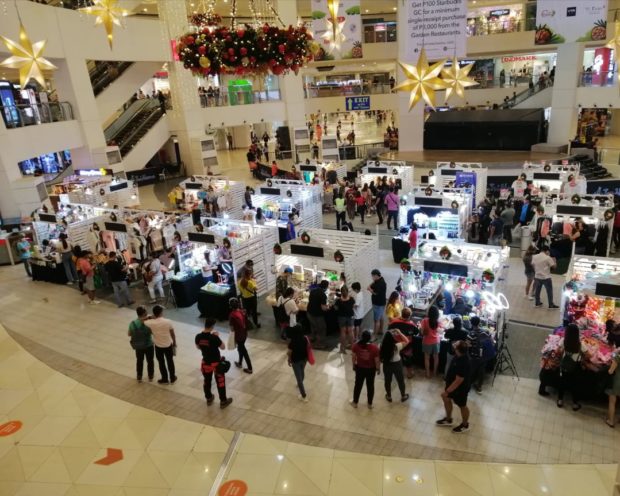Complacency under alert level 2 worries DOH

People while their time at a big shopping mall in Quezon City on Saturday, November 6, 2021. The government’s pandemic task force has placed the entire Metro Manila under COVID-19 Alert Level 2 since November 5. INQUIRER.net/Katherine G. Adraneda
MANILA, Philippines — The Department of Health (DOH) warns that active COVID-19 cases in the country may shoot up again in December if Filipinos will let their guard down and become complacent in observing health protocols, now that Metro Manila is under the more relaxed alert level 2.
Health Undersecretary Maria Rosario Vergeire, citing projections by the DOH’s disease surveillance team, said active cases might reach 52,393 next month if safety measures against COVID-19 were ignored and pandemic response, specifically the detection and isolation of cases, would slow down.
“If we completely relax our adherence to safety protocols, if the detection-to-isolation [rate] will take [more than five days], and mobility would increase, we can have these [high] numbers until the end of December,” Vergeire said at the Laging Handa briefing on Saturday. But if current movement restrictions, now at about 82 percent, are maintained and detection-to-isolation rate is kept at five days or less, active cases are expected to drop to 22,000 by Nov. 15, according to Vergeire.
The DOH team is called the Feasibility Analysis of Syndromic Surveillance Using Spatio-Temporal Epidemiological Modeler For Early Detection of Diseases (FASSSTER).
Highest in five days
The country’s active case count started to fall below the 50,000-mark on Oct. 30 and has since been on a downward trend. Active cases yesterday stood at 34,866.
Article continues after this advertisementDirector Alethea de Guzman of the DOH’s epidemiology bureau earlier said the “assumptions used to create scenarios” in COVID-19 case projections were: mobility, adherence to minimum public health standards, health system capacity and vaccination coverage.
Article continues after this advertisementNew COVID-19 daily infections hit 2,656 on Saturday, the highest in the last five days. This raised the total number of cases to 2,800,621.
Of the active cases, 67 percent had mild symptoms; 14.9 percent, moderate; 8.7 percent, severe; 5.6 percent, asymptomatic; and 3.7 percent, critical.
There were 5,130 patients who recovered, bringing the total number of recoveries to 2,721,516.
The country’s death toll stood at 44,239 after 154 new fatalities were registered.
Vergeire, however, clarified during the briefing that the daily death count did not reflect the actual number of fatalities recorded per day because data from the local governments had to be validated first before they could be included in the case bulletin.
First-day violations
She said that the country was now averaging 10 deaths a day compared to 193 deaths a day in September. The positivity rate dipped to 5.6 percent, now closer to the below 5 percent recommended by the World Health Organization. In the meantime, the Philippine National Police logged 9,451 violations of pandemic protocols on Friday, the first day of implementation of alert level 2 in Metro Manila.
The number, according to PNP chief Gen. Guillermo Eleazar, was slightly lower than the daily average violations of 9,746 in the 20 days when Metro Manila was under the stricter alert level 3.
Of the breaches logged on Friday, 10 percent were curfew violations, lower than the 24 percent recorded under alert level 3.
Curfew was lifted in Metro Manila starting Nov. 4 but some local governments continued to impose it only on minors, with their city or municipal ordinances as legal basis.
Eleazar did not specify the other violations committed but the usual offenses recorded by the PNP in the past included nonwearing of face masks and failure to observe physical distancing.
On Thursday, the Inter-Agency Task Force for the Management of Emerging Infectious Diseases (IATF) placed Metro Manila under the more relaxed alert level 2.
This allowed cinemas, theaters, theme parks, swimming pools, libraries, museums and other tourist attractions, as well as venues for social gatherings to open for the first time in more than a year. It also allowed an increase in the operating capacities of businesses like restaurants and personal care establishments.
No age-based mobility
Under alert level 2, there is also no age-based mobility restrictions in Metro Manila.
At the Laging Handa briefing, Eleazar said the PNP would intensify its monitoring of the public’s compliance with health protocols under more relaxed restrictions.
“There are looser movement restrictions for the people, but the police would not ease up [on monitoring compliance]. In fact, we would be stricter in implementing health protocols,” he said.
Eleazar said he had directed chiefs of police to identify areas where people tend to converge so they could plan accordingly.
Alert level system nationwide
Also on Saturday, Eleazar directed all police regional offices outside Metro Manila to prepare for the nationwide enforcement of the five-level alert level system starting Dec. 1, as announced by the DOH.
He said provincial and city police officials should be familiar with the guidelines for each alert level to ensure their proper implementation and avoid confusion in the enforcement of the protocols.
The police should expect restrictions to ease once the alert level system is implemented in the provinces and prompt more people to go out and more business establishments to reopen.
The government began the pilot of the alert level system accompanied by granular lockdowns in Metro Manila in September. This was later expanded to select provinces and cities in October.
For more news about the novel coronavirus click here.
What you need to know about Coronavirus.
For more information on COVID-19, call the DOH Hotline: (02) 86517800 local 1149/1150.
The Inquirer Foundation supports our healthcare frontliners and is still accepting cash donations to be deposited at Banco de Oro (BDO) current account #007960018860 or donate through PayMaya using this link.